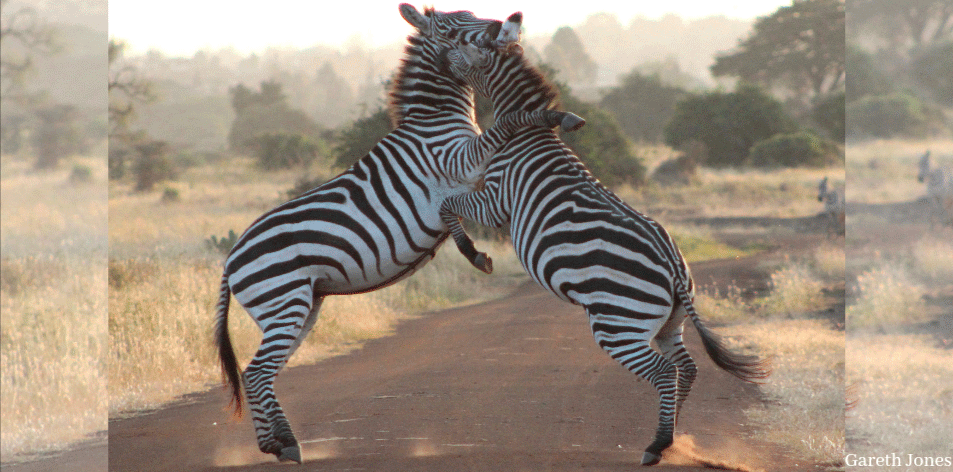
Wild Striped Equines!!!- Article by Gareth Jones
Wild Striped Equines Of Nairobi National Park
It was getting hot in the car as the sun rose high overhead. As we rounded a corner, a herd of magnificently patterned creatures stood in the road, they were seemingly dazed by the heat of the day. Just then, one of the zebra found a sandy spot next to the road and began to roll onto its back. As many of these zebra sleepily stood in the road, I was able to drive very slowly, until they were almost right next to me. Being so close allowed me to study the fine details on them, like the many parasitic ticks around their eyes. Their patterned stripes were all very unique & none of them were the same. To me, this is just more incredible evidence of the signature of God in creation. There are many other examples of unique identification patterns in other creatures, for example, lions and leopards have whisker pattern dots that are always different, like a facial code. African wild dogs also have patterns that are all uniquely different. With the zebra being so close and almost personal, at times I make a soft horsy type communication call to them, a “phiff…phiff…phiff” sort of sound, and very often they respond with a similar sound.
Year after year, the plain’s zebra faithfully return to the Nairobi park to seek fine pasture. In recent years, this feat is becoming more and more challenging with the pressures of human encroachment. So it continues to be amazing that they somehow still return in such numbers each year, totaling quite a few thousand.
It has always been a favorite habit of mine to approach a herd of zebra, slowly idle and edge the vehicle closer and closer until virtually in the middle of the herd and then switch off the vehicle and observe them. A particularly strange activity that they do is to find a patch of dust and then repeatedly roll in it, effectively dust bathing their coats. Often, the herd seemingly waits in line to all roll on exactly the same dust spot. There are various possible reasons for this behavior, including a protective dust layer that results in minimizing parasites and thermo-cooling their coats in the African heat. Maybe the action could also be linked to communal scent marking of the herd? Whatever the reasons, it is always interesting to watch the zebra when they are “on the roll”!!
There are two sub-genus of zebra, namely Hippotigris & Dolichohippus. There are 5 subspecies across Africa in the genus Hippotigris of which the plain’s zebra in East Africa is classified. The name zebra comes from the old Portuguese word “ZEVRA” meaning “wild ass”, and in Swahili they are known as Punda Milia. Sometimes it can be very rewarding to just sit quietly near a herd of zebra and watch them for a while. Zebra tend to be quite habitual in their daily habits, so waiting at a dam, can be special when zebra and other species come and drink. Interestingly, zebra often walk deep into the water, perhaps because it is cooling and easier to drink. However, their deep water drinking habits can expose them to the dangers of becoming a crocodile meal. We recently observed a zebra with a severe leg wound that had most likely been the result of a life & death “tug of war” with a large crocodile.
They are quite observant and very sensitive regarding predator awareness. For decades and decades, scientists have wondered why zebras have stripes. One prevailing theory held that the stripes confused predators, making it harder for, say, a lion to pick out an individual zebra from a stampeding herd.
Lately, more intriguing theories have emerged. Some scientists think that stripes keep zebras cooler. The dark stripes soak up more sunlight than the light ones, and this stirs up eddies of wind that swirl heat away. Other researchers discovered that biting flies avoid striped patterns. And the two theories might be linked: Biting flies prefer hot temperatures, so they may be less likely to bite a cooler zebra.
For fussy grazers such as Thomson’s gazelles and wildebeest, zebras are their unlikely feeding friends. Those striped heroes have special digestive systems that can quickly process lower-quality forage. Plain’s zebras are often the first to enter an un-grazed grassy area. They’ll munch on older, harder, less nutritious plants that other grazers can’t eat. Once the old stuff is cleared out, tender new growth pops up. More fussy, selective grazers will then wander in and eat the good stuff.
While sometimes zebra seem to be calm and placid, there are times when some of them, particularly stallions, can be very aggressive when they fight. It is then when they fight for dominance and mating rights that they can be really vicious, as they kick and bite each other. I have seen quite a few ugly looking wounds on many zebras due to their “war wounds”, it is at such times that they definitely are wild striped equines. I have seen many encounters with lions by just sitting still with a herd of zebra, and watching and waiting. By the way, are zebras white with black stripes, or black with white stripes? Well, then it’s no wonder their combined dazzle of moving patterns can even confuse a predator like a lion. Yes, these wild striped equines are indeed interesting creatures!


